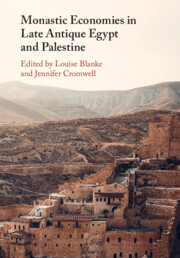Book contents
- Monastic Economies in Late Antique Egypt and Palestine
- Monastic Economies in Late Antique Egypt and Palestine
- Copyright page
- Contents
- Figures
- Tables
- Contributors
- Preface
- 1 The Monastic Economies in Late Antique Egypt and Palestine: Past, Present, and Future
- I. The Monastic Estate
- II. Production and Consumption of Food and Material Goods
- 5 Monastic Vintages: The Economic Role of Wine in Egyptian Monasteries in the Sixth to Eighth Centuries
- 6 Cooking, Baking, and Serving: A Window into the Kitchen of Egyptian Monastic Households and the Archaeology of Cooking
- 7 The Refectory and the Kitchen in the Early Byzantine Monastery of Tell Bi’a (Syria): The Egyptian and Palestinian Connections
- 8 It’s a Dung Job: Exploring Fuel Disc Production in Egyptian Monasteries
- 9 Illuminating the Scriptoria: Monastic Book Production at the Medieval Monastery of St Michael
- III. Monastic Encounters: Travel, Pilgrimage, and Donations
- Glossary
- Index
- References
9 - Illuminating the Scriptoria: Monastic Book Production at the Medieval Monastery of St Michael
from II. - Production and Consumption of Food and Material Goods
Published online by Cambridge University Press: 14 April 2023
- Monastic Economies in Late Antique Egypt and Palestine
- Monastic Economies in Late Antique Egypt and Palestine
- Copyright page
- Contents
- Figures
- Tables
- Contributors
- Preface
- 1 The Monastic Economies in Late Antique Egypt and Palestine: Past, Present, and Future
- I. The Monastic Estate
- II. Production and Consumption of Food and Material Goods
- 5 Monastic Vintages: The Economic Role of Wine in Egyptian Monasteries in the Sixth to Eighth Centuries
- 6 Cooking, Baking, and Serving: A Window into the Kitchen of Egyptian Monastic Households and the Archaeology of Cooking
- 7 The Refectory and the Kitchen in the Early Byzantine Monastery of Tell Bi’a (Syria): The Egyptian and Palestinian Connections
- 8 It’s a Dung Job: Exploring Fuel Disc Production in Egyptian Monasteries
- 9 Illuminating the Scriptoria: Monastic Book Production at the Medieval Monastery of St Michael
- III. Monastic Encounters: Travel, Pilgrimage, and Donations
- Glossary
- Index
- References
Summary
The St Michael Collection (dating from 823 to 914) from the Fayum Oasis is the earliest extant group of painted Coptic manuscripts and is impressive because it has remained together as a cohesive whole. The manuscripts reveal aspects of monastic book production ranging from acquisition of materials to the practices of scribes and painters, as well as aspects of book culture, from the dedication of books to sharing them across a regional network of monasteries. The study of this unique collection allows the cost of these manuscripts to be estimated, using inferences about the materials, time, and effort required to produce them. The results of this analysis enhance our understanding of the relationships among patrons, books, monasteries, and scribes in the ninth and tenth centuries in the Fayum Oasis. Ultimately, this chapter argues that, within the context of the Egyptian monastic economy, the production of these books was not expensive. Yet, the cost of books in the medieval period was still perceived to be high.
- Type
- Chapter
- Information
- Monastic Economies in Late Antique Egypt and Palestine , pp. 233 - 268Publisher: Cambridge University PressPrint publication year: 2023

